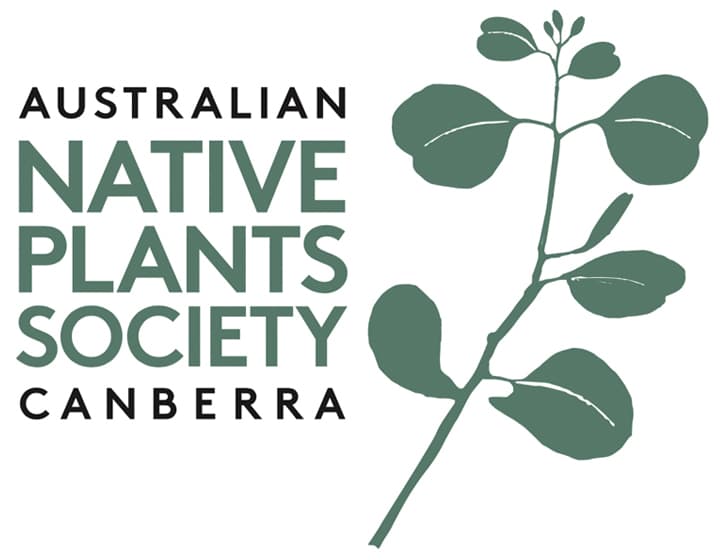Wednesday Walks
By Words and photos by Roger Farrow unless otherwise stated
Sept 2022

Our Wednesday Walks are continuing on a weekly basis, subject to weather conditions. We had a number of forays into the countryside surrounding the ACT as well as in Canberra itself. Following are a few of those walks.
Alison Hone Reserve, north of Goulburn :
In the middle of winter at the time of the shortest day, it is always difficult to find a walk that will yield some plants in flower. However, it is also a time to test our knowledge about identifying plants from just their leaves and buds, and the dry sclerophyll forests of the local region provide such a challenge.
The Alison Hone Nature Reserve north of Goulburn is a former Crown Land Timber Reserve that is managed by members of the Southern Tablelands Native Plant Society based in Goulburn. It was created to protect a rare beardless orchid Calochilus imberbis discovered by Alison Hone in the 1980s. It contains an additional 17 species of orchid as well as a range of interesting woodland plants.
On our visit, we circumnavigated the reserve through a range of different habitats covering the south-facing cooler and wetter slopes as well as the more extensive areas of drier north-facing slopes. The dominant flowering shrub was Acacia genistifolia but seven other Acacias were seen including three in flower — gunnii, lanigera and terminalis. Other shrubs in flower included Leucopogon muticus, Hakea decurrens, a single Olearia microphylla (a new record) and a very few Pultenaea microphylla. L. muticus is an interesting Bearded Heath as the solitary shrubs here grow up to two metres tall. Leucopogons are notoriously difficult to grow from cuttings or seed but these shrubs were surrounded by a number of small seedlings up to 10 cm tall. There were extensive areas of shrubby peas in leaf that would make a great flower display in early summer.
The lower northern slopes were covered with dense thickets of Cassinia siftoni and C. aculeata that would have germinated and grown following the drought-breaking rains of 2020. There was some discussion over the daisy rosettes and of how to distinguish Coronidium gunnianum (replacing Helichrysum rutidolepis) from C. scorpioides at this stage, with no clear outcome. 18 orchid species have been recorded, but at this time of year only tiny rosettes of Diplodium truncatum and Speculantha rubescens were seen.
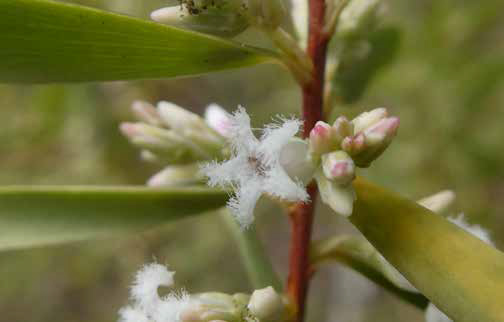
Melrose Nature Reserve and adjoining areas, Tuggeranong:
It’s not often that we discover a new area of botanical interest to survey in the ACT that has been well covered by Wednesday Walkers over the years. Between the Monaro Highway and the disused Cooma railway line to the south of the ACT, lies the Melrose Nature Reserve. It consists of a hilly area of partially cleared heathland and grassland with patches of dry sclerophyll forest and some deeply incised creeks.
The railway line easement, that actually lies in NSW, is also of high botanic interest as it consists of remnant native heathland containing the endangered Small Purple Pea, Swainsona recta. Our survey took us from the southern end of the reserve to the railway line easement, Rosettes of Blushing Tiny Greenhoods, Speculantha rubescens which we followed for about two kilometres before heading north through open forest and heathland and several creek crossings to the Tuggeranong Pines where we had left our cars. The reserve is noted for its large population of Grey Beard Heath, Leucopogon attenuatus, that is the first in the genus to flower in midwinter. We were not disappointed: its fluffy white blossoms covered many parts of the landscape starting along the railway line. We identified many of the usual shrubs and several patches of orchid rosettes along this stretch as well as eucalypts like Longleaved Bundy, Eucalyptus goniocalyx, and some heavy infestations of the mistletoe, Amyema miquelii.
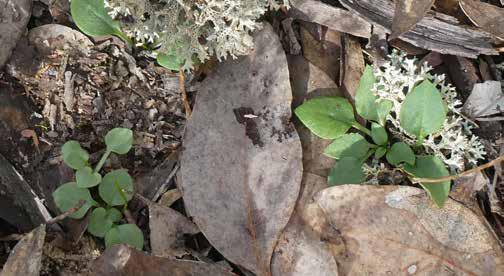
Our most remarkable discovery, after leaving the railway line, was a hillside densely covered with shrubs of Cryptandra sp Floriferous, living up to its name in full flower Among these plants was the common Cryptandra amara yet to flower. The open forest here had some venerable specimens of Scribbly Gum, E. rossii, including one with a tree hollow at its top that a pair of rainbow lorikeets was inspecting.
After crossing several gullies we aimed for the power lines crossing the reserve where a track led us to our destination. On this final stretch, we passed through a different type of heath dominated by Calytrix tetragona and Kunzea phylicoides, noting a change in the geology from shales to granite. A very rewarding day apart from the gates that seem to have the purpose of keeping people out rather than allowing access.
Shepherds Lookout:
An unpredicted band of rain crossed the ACT on the morning of 3rd August, causing the advertised walk from Shepherds Lockout, Belconnen to be cancelled. However, at midday the sun made its presence felt and two WWers, missing their usual walk, and in want of exercise decided to check out the walk which is new to the program. The walk starts from the Lookout and descends to the banks of the Molonglo, a distance of 1.5 km and takes about two hours (return). The Molonglo can be crossed at low water with two trails continuing to Uriarra crossing. The walk descends steeply from the Lookout down a stepped trail through a forest of black cypress, Callitris endlicheri, the largest stand in the ACT. It then follows an undulating track across a rocky grassy hillside next to the Water Treatment Plant, above the Murrumbidgee. Unfortunately, much of this grassland has been invaded by African lovegrass, but there are places where the remnant kangaroo grass is still dominant. Scattered shrubs of Kunzea ambigua, Brachyloma daphnoides and Cryptandra amara (in bud) occur along this section. In summer a variety of native herbaceous plants would probably be present here.
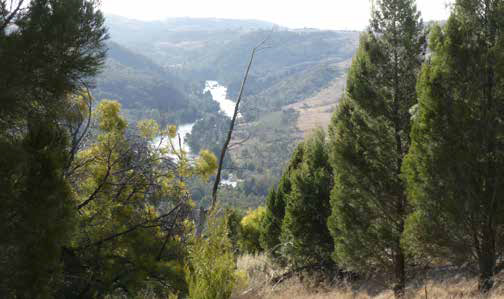
The trail then descends steeply down more steps to the river flats, dominated by black wattle and river she oak, with a largely weedy understory. In summary, the walk is notably for its scenery, overlooking the confluence of the Molonglo and Murrumbidgee with fine views of the Lookout, rather than the quality of the native vegetation.
Mulloon Fire Trail through Tallaganda National Park:
We always anticipate the drive along the Mulloon Fire Trail with some trepidation because of the potential obstacles that can be encountered i.e. a large tree fallen over and blocking the road, Mulloon Creek in flood, road washed away, Park closed because of fire, trail closed by Council for repairs. All of these have happened to us on attempted visits over the years. This time we need not have worried as the road had been graded and was in fine shape although the climb out of Mulloon Creek still required high clearance.
The fire trail passes through different vegetation types, depending on aspect and geology. The first western section winds through manna gum, Eucalyptus viminalis, and broad-leaved peppermint, E.dives, which are regenerating well, following the 2020 mega-fire, to the extent that the sapling regrowth from seed is impenetrable in parts.
Then the trail ascends to the Palerang saddle dominated by silver-topped ash, E. sieberi, and a very diverse understory of regenerating shrubs. Next, the trail descends through a forest of giant messmates, E. obliqua, sprouting back by epicormic growth plus an understory of Goodia lotifolia, that is a riot of yellow in spring. This has regenerated from seed.
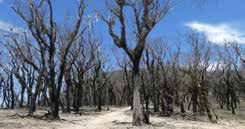
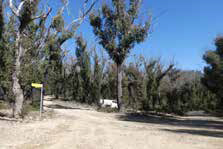

Finally, the trail passes through a low forest of gums growing in the nutrient poor sandstones of the Shoalhaven alongside Little Bombay Creek. This area is noted for the Banksia spinulosa understory (in full flower) and a range of different Pomaderris species regenerating from seed. Some areas are covered with impenetrable thickets of Acacia mearnsii saplings that germinated post-fire.
In order to revisit the same sites along the trail, where we have noted particular features of the vegetation, special plant species, and other physical features, we follow a mileage record. This was set up by Ros Cornish and myself, with about 30 potential ‘stops’ along a 19 km section of the trail from the sign at the start of the park to the end at the Tally-ho fire trail. This record has been particularly useful when comparing the vegetation before and after the mega-fire when the understory was completely incinerated and featureless except for the rock outcrops.
Our conclusion is that the vegetation is highly fire adapted and that all the species present before the fire are regenerating by either seed e.g. Pomaderris, peas and acacias and many others; by lignotubers and rootstocks e.g. sedges and lomandras etc.; by underground bulbs and corms e.g. orchids and lilies; or by epicormic regrowth e.g. eucalypts.
Bungonia Karst Conservation Area:
One the most spectacular karst landscapes lies on our doorstep at Bungonia where the limestone escarpment plunges into the Bungonia Creek slot canyon. Plants cling to the sides of the cliffs by roots that penetrate the crevices in the limestones and caves dot the landscape.
The easy Green walk encircles the plateau connecting all the lookouts. We stop at the Kerrileae parking area and walk counter clockwise around the loop with a short foray along the Orange track to look for the rare trim greenhood forked labellum.
We arrive on a clear sunny but cold day. Our first impressions were of the festoons of Clematis leptophylla (formerly L.microphylla) in full flower and of C.glycinoides. It is clear that the past two wet years have resulted in a mass recruitment of many species from the seed bank, especially understory shrubs, such as the dominant sticky daisy bush, Olearia viscidula.
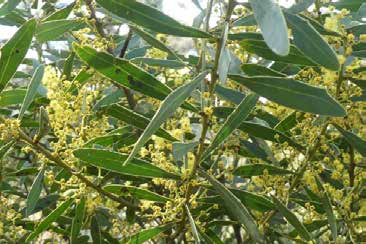
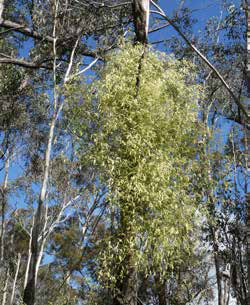
The first part of the route passes through tall open forest of boxes, stringybarks, and gums, including Eucalyptus mollucana, E.globoidea, and E.amplifolia, among others. The sparse understory is enlivened by patches of Acacia genistifolia in full flower and the green of hopbush seedlings. At the first of the lookouts (Bungonia Lookdowns), we find Boomerang wattle, Acacia amoena, in flower (a first for us), as well as flowers of a Pandorea clinging to the cliff below. There is a spectacular view to the distant escarpment above the Shoalhaven, now showing no signs of the 2020 mega fire.
The next section of the Green loop passes through more open forest of stringybarks, with a large patch of ploughshare wattle, A gunnii, in flower, a new record for us. It then crosses a challenging deep gully and into casuarina forest before reaching the Jerrawa lookout. This area has a range of shrubs seen nowhere else in the park, including Lasiopetalum macrophyllum, a startling blue coloured Beyeria viscosa, the endemic wattle A binerva, Scaevola purpurea, Zieria cytoides and the enigmatic grey bush, Cyphanthera albicans, that is seldom seen, another new record for us (thanks Kris for the ID).
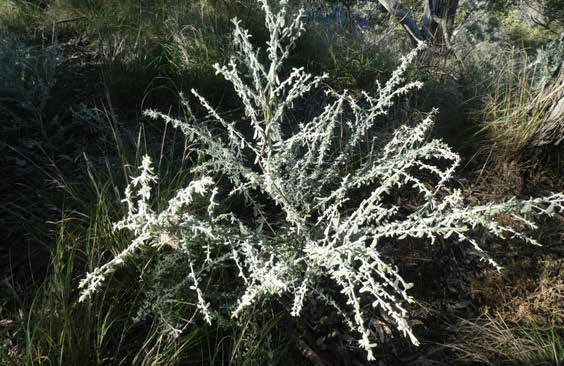
Unfortunately, time prevented us from completing the last section of the loop and we returned by the road to the carpark. This was fortuitous because up until now, we had not seen the trim greenhood but Jeanette spotted a clump in flower in a precarious position in gravel on the roadside bank just 50 m from the end of our walk, a great relief for Jean to find them. Unfortunately, it was not in the best condition because of some marauding chewer. We added five new species to the list, so overall a very successful outing.
Molonglo Gorge Report: By Jo Walker
Three of us made our way through the length of Molonglo Gorge to the Blue Tiles picnic area where we shared our lunch with a pair of friendly Magpies. We had followed the narrow undulating track along the side of the steep northern hillside — rocky and a bit muddy in places but easy enough to walk on.
The hillside is covered in open forest consisting of Callitris endlicheri, Eucalyptus macrorhyncha, E.bridgesiana, E.nortonii and a few E.rossii. The trees have gone through many hard times — drought, fire and floods (which reach quite high levels in the narrow gorge). This has resulted in many of the E.bridgesiana being multi-stemmed or having trunks and branches twisted into strange shapes.
Not much was in flower. But Acacia dealbata and A.rubida were still displaying their golden flowers, and there were a few Hardenbergia violacea and Hovea heterophylla adding a bit of purple to the landscape. There was also a Clematis leptophylla covering a bush with its cream flowers and reaching into a nearby tree. And, because of the recent wet weather, mosses and lichens of various shades of green were carpeting the hillsides and adorning the rocks. An interesting find was a small Phebalium squamulosum ssp. ozothamnoides covered in clusters of small bronze buds and growing just beside the path.
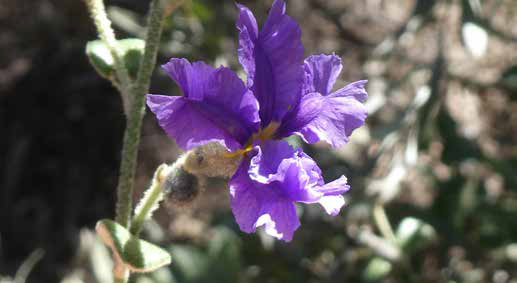
We heard a few birds, including a Bronze Cuckoo, along the way. But the main background sound that accompanied us on the whole walk was the loud rushing of white water hurtling through the rocky riverbed and reminding us of how, over many millions of years, this lovely place was formed.
Black Mountain: Report and images: Jean Egan
On a very crisp Canberra late winter morning (-6C overnight) 12 hardy souls met at the Caswell Drive entrance to Black Mountain. The day warmed up to be perfect walking conditions with a deep blue almost cloudless sky. The Mountain is looking very green with the small dam under the powerlines full. The lower tracks were occasionally damp underfoot, but once we moved to higher ground it was not a problem.
The community of choughs that reside close to the small dam treated our presence with the usual contempt and continued with their morning foraging. The first signs of Spring were evident, with abundance of yellow from the Wattles, white from the Leucopogon attenuatus, and purple from the Hardenbergia violacea and Hovea heterophylla.
It was also rewarding to see the Grevillia alpina just showing colour as were the Hakea decurrens, Pimelea linifolia, Indigofera australis, and Stypandra glauca to name just a few.
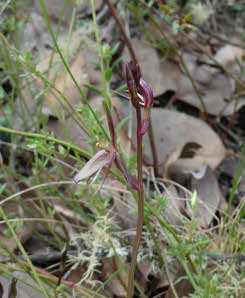
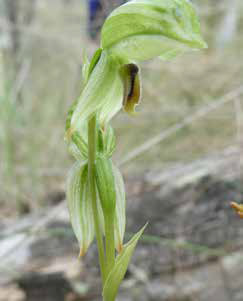
Five orchids were also in flower, Pterostylis nutans, Bunochilus umbrinus, Cyrtostylis reniformis, Corysanthes incurva, and Acianthus collinus. Also with advanced buds were Lyperanthus suaveolens, Pterostylis pedunculata and Oligochaetochilus aciculiformis. Many others had leaves just emerging, promising to be another bumper Spring showing.
The highlight of the day came near the end of the walk. After recording three species of Wattle, Acacia buxifolia, A.genistifolia and A.gunnii, on a steep corner slope some small shrubs were found that have been identified as A lanigera or A lanigera var lanigera, (to be confirmed). They were in full bloom and putting on a stunning show.
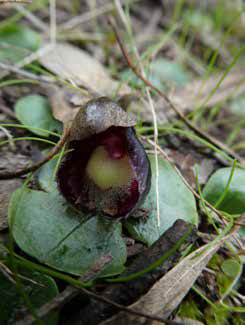

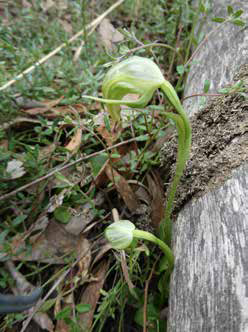
A perfect ending to a great day out.
Back to Articles List
